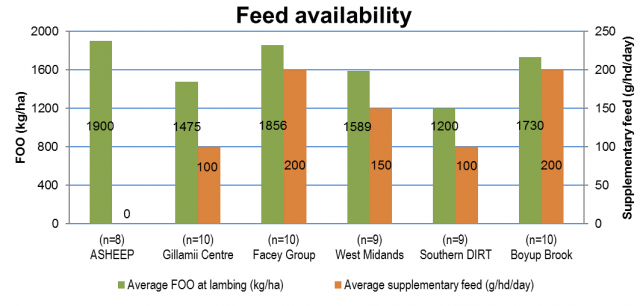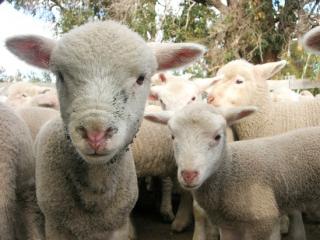Lamb Survival Initiative results 2016
Rebecca Butcher, Department of Primary Industries and Regional Development (DPIRD), Moora
Corresponding author: rebecca.butcher@dpird.wa.gov.au
This article presents the results of the 2016 Lamb Survival Initiative. The results of the 2015 Lamb Survival Initiative were published in the March 2016 edition of the Ovine Observer.
Introduction
Just over 6% of Western Australian (WA) Merino sheep producers and 9% of dedicated prime lamb producers achieve marking rates of over 100%. This means that less than 500 producers in WA achieve 100%+ lamb marking in any given year.
The Lamb Survival Initiative, through involvement with regional grower groups, aims to provide the support required for producers to achieve 100%+ lamb marking rates. The initiative provides training and support, encouraging producers to set achievable targets and benchmarking their marking rates against producers in similar regions and across the state.
In order to build producer confidence and skills to lift marking rates to 100%+ the initiative encourages producers to:
- undertake pregnancy scanning for multiples on a significant proportion of their adult ewes
- record and submit data on the reproductive rate, marking rate and weaning rate achieved in the scanned ewe flock/s so that the rates can be benchmarked against producers in similar regions
- attend at least one training course or workshop focused on reproduction
- work closely with industry professionals if reproduction rates are less than expected.
2016 was the second year of the Lamb Survival Initiative, and involved six grower groups spread throughout the southern region of WA. These groups included Facey Group (Wickepin), Southern DIRT (Kojonup), the Gillamii Centre (Cranbrook), ASHEEP (Esperance) and two independent groups from the West Midlands and Boyup Brook, with a total of 34 participants.
Lifetime Ewe Management accredited facilitators Ed Riggall and Jonathan England were selected by the groups to provide in-depth information on reproduction. Facilitators met either on-farm with each producer or via group meetings to provide support and training on topics such as condition scoring, feed budgeting and husbandry practices for increasing lamb survival.
Information collected about the reproductive cycle included:
- ewe condition score at rams out and pregnancy scanning
- scanning rate (number of lambs scanned per 100 ewes joined)
- marking rate (number of lambs marked per 100 ewes joined)
- weaning rate (number of lambs weaned per 100 ewes joined)
- weaning weights (where facilities available)
- feed on offer (FOO) at lambing and details of supplementary feeding.
Collection of this information enabled producers to gain valuable understanding on where lambs were being lost throughout the reproductive cycle.
Ewe condition score
As shown in Figure 1, producers from the ASHEEP and Gillamii Centre groups maintained a high average condition score (CS) in their ewes between rams out and pregnancy scanning. Producers from the West Midlands and Southern DIRT groups saw a moderate increase in average ewe CS of 10%, while producers from the Facey Group and Boyup Brook groups saw a slight increase between rams out and pregnancy scanning.

Feed availability
In 2016, average FOO at lambing was high for all groups. The lowest average FOO for any of the groups in 2016, 1200 kilograms/hectare (kg/ha), was greater than the highest average FOO in 2015 (1060kg/ha) when most areas received decile 1 rainfall during the growing season.
The available feed (supplementary feeding and FOO) for each of the groups at lambing can be seen in Figure 2, which shows that in most groups producers continued to offer supplementary feed to ewes even when FOO was high. A variety of supplementary feeds were used including hay, wheat seconds, oats, barley, an oat/barley mix and/or lupins. The majority of the supplementary feed recorded was used for feeding twin-bearing ewes.

Reproductive rates

Reproductive rates included the number of lambs scanned, marked and weaned per 100 ewes joined (Figure 3). As in 2015, the greatest lamb loss for each group occurred between pregnancy scanning (blue) and lamb marking (red). This mortality may be either in-utero, during the birthing process, or during the first 72 hours of life. It has been found that 80% of lamb mortality occurs during the first 72 hours of life.
The Facey Group and Gillami Centre groups recorded surprising results that indicated the number of lambs weaned (green) increased from the number of lambs marked (red). These results may reflect some out-of-season lambing and/or ewes and lambs that weren’t present at marking.
Weaning weight
While not all producers involved in the project recorded lamb weights at weaning, the average weaning weights are shown in Figure 4.
There are many strategies that can be put in place to increase lamb survival including monitoring the CS of ewes, scanning for multiples foetuses and preferentially feeding twin-bearing ewes, as well as providing shelter and limiting mob size at lambing.
Further information on increasing lamb survival can be found in the September 2015 edition of Ovine Observer or on the DPIRD website.
Producer feedback
Feedback from producers involved in the initiative indicated that further extension of information about weaner management as well as pasture production and management was highly desirable. DPIRD has responded to this feedback by increasing the number of producer seminars covering these topics (e.g. Managing sheep in the dry spring seminars, held in July 2017).
Participation
If you would like to become involved in the 2018 season of the Lamb Survival Initiative, please contact Rebecca Butcher, Sheep Industry Development Officer, Moora on +61 (0)8 9651 0540 or rebecca.butcher@dpird.wa.gov.au.


